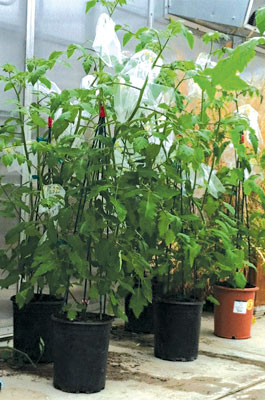 |
| For this pollinator study, tomato plants in 5-gallon buckets had some of the flower clusters covered with net bags before they went into the field. Photo courtesy of San Francisco State University |
By Sue Smith-Heavenrich
A study released earlier this year from San Francisco State University shows that native bees provide an important pollination service in the city. And it wasn’t the size of the garden that determined whether crops were adequately pollinated but the abundance of flowering plants.
In 2012, Professor Gretchen LeBuhn and then-graduate student Andrew Potter set out to investigate the role of wild bees in pollinating urban tomatoes. They established 18 study sites in urban gardens around San Francisco, chosen at random from a list of more than 200 school and community gardens. Then they had to decide which crop plant to use.
Because they wanted to focus on pollination by native bees, they needed a plant that would require pollination but also be unattractive to honeybees. So they chose ‘Sungold’ cherry tomatoes. Like other tomatoes, ‘Sungold’ blossoms are “perfect” flowers – i.e., they have both male and female parts. But in this variety, the stigma projects well beyond the anthers, making self-pollination difficult. Also, releasing pollen from anthers takes a bit of work, requiring the kind of movements known as “buzz pollination” used by bumblebees and some solitary bees. Since the pollen would be hard to harvest, and since tomato flowers produce no nectar, honeybee visits would be rare.
In early June, LeBuhn and Potter set out three tomato plants at each garden site. Each plant had net bags over some flower clusters, while others were open to pollinators. The flower clusters covered by net bags were divided into three groups: control (nothing would be done); artificially self-pollinated (with sound vibrations); and artificially cross-pollinated (dipped into pollen collected from other plants). After two weeks, the plants were returned to the greenhouse to allow for fruit development in a controlled environment.
In addition to fruit set, fruit mass, yield and seed set, the scientists noted landscape variables for each garden site, including impervious surfaces (roads, rooftops) and flower abundance.
The scientists were surprised by their results. Flower clusters pollinated by bees out-produced the control group, yielding more and larger tomatoes. Not only that, bee-pollinated clusters did as well or better than artificially pollinated clusters. That, says LeBuhn, suggests that cities can support adequate pollination service for “urban agriculture.”
Even more surprising, though, was learning that garden size didn’t matter. Neither did the amount of green space in the surrounding area. What did make a difference was “floral resource density” – the number of flowers blooming in the garden where the tomato was placed. Instead of luring bees away from the tomatoes, the presence of flowers did just the opposite, attracting foraging bees to the tomatoes.
The take-away lesson: Small gardens with lots of flowers are enough to attract native bees – as long as there is a diverse population of bees to begin with. This is good news for small-scale urban gardeners interested in creating sustainable local food networks. At the same time, it highlights the need to conserve pollinator habitat in cities. Increasing habitat is critical, says LeBuhn who would like to see more people make their backyard gardens, local parks and school yards more pollinator-friendly.
While the pollinator service in San Francisco is adequate at this time, LeBuhn warns that if native bee populations are not sustained, we could see a significant decline in urban agriculture. To increase awareness about the plight of pollinators, she’s expanded her citizen science project to include “The Great Pollinator Habitat Challenge” which began this May. Learn more at https://www.greatsunflower.org/
Journal Reference: Pollination service to urban agriculture in San Francisco, CA, by Andrew Potter and Gretchen LeBuhn, Urban Ecosystems, 2015
